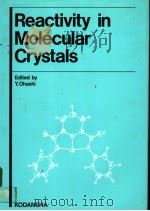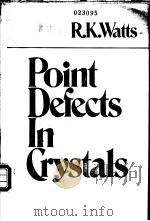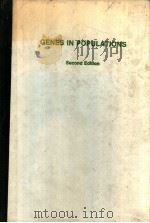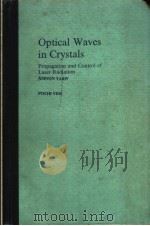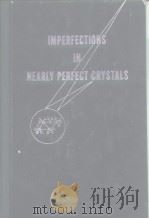《IMPERFECTIONS IN CRYSTALS SECOND EDITION》
| 作者 | H.G. VAN BUEREN 编者 |
|---|---|
| 出版 | NORTH-HOLLAND PUBLISHING COMPANY |
| 参考页数 | 676 |
| 出版时间 | 1961(求助前请核对) 目录预览 |
| ISBN号 | 无 — 求助条款 |
| PDF编号 | 813343268(仅供预览,未存储实际文件) |
| 求助格式 | 扫描PDF(若分多册发行,每次仅能受理1册) |
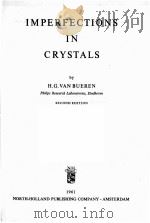
INTRODUCTION1
PART ⅠGENERAL PROPERTIES OF LATTICE IMPERFECTIONS5
CHAPTER ⅠTHE PERFECT CRYSTAL7
1.The crystallographic lattice7
2.Physical properties9
3.The vibrating lattice16
4.Electronic structure of crystals20
CHAPTER ⅡPOINT DEFECTS IN CRYSTALS28
1.Geometrical considerations28
2.Energy of formation of point defects in crystals31
2.1.Simple defects31
2.2.Association of point defects;crowdions and interstitialcies33
3.Point defects in thermal equilibrium36
4.Formation of vacancies and interstitials in non-equilibrium concentra-tions40
4.1.Effects of impurities40
4.2.Effects of physical treatment41
CHAPTER ⅢGEOMETRICAL DESCRIPTION OF DISLOCATIONS45
1.Structure of dislocations45
2.Displacements and stresses around dislocations52
3.Interaction between dislocations57
4.Interaction between dislocations and point defects59
5.Motion of dislocations62
5.1.Glide motion62
5.2.Climb motion67
5.3.Motion of jogged dislocations69
5.4.High-speed motion70
6.Formation of dislocations71
7.Types of dislocations occurring in various crystal structures76
CHAPTER ⅣMATHEMATICAL THEORY OF LATTICE IMPERFECTIONS80
1.Introduction80
2.Classical theory of elasticity81
2.1.Stress,strain and their equations81
2.2.Differential equations for stresses and strains86
2.3.Two-dimensional problems88
3.Singularities in three-dimensional strain90
4.Singularities in two-dimensional strain95
4.1.Plane strain95
4.2.Anti-plane strain102
5.Continuum theory of dislocations104
5.1.Dislocations as sources of internal stress104
5.2.Description of imperfections106
6.Classification of dislocations in elastic continua110
6.1.Somigliana and Volterra dislocations110
7.Force on a dislocation112
8.Defects in crystalline solids113
8.1.Point defects113
8.2.Dislocations116
PART ⅡIMPERFECTIONS IN METALS121
CHAPTER ⅤSPECIAL PROPERTIES OF LATTICE IMPERFECTIONS IN METALLIC CRYSTALS123
1.Electrical resistance of lattice imperfections in metals123
1.1.Vacancies and interstitials123
1.2.Dislocations124
1.3.Magnetoresistivity of dislocations125
2.Thermal conductivity and lattice imperfections126
3.X-ray and electron scattering by dislocations127
4.Rendering lattice imperfections visible128
4.1.Etch pits and dislocations129
4.2.Other methods for detecting individual dislocations132
CHAPTER ⅥPLASTIC DEFORMATION OF METALS CONSIDERED AS MOVEMENT OF DISLOCATIONS135
1.Visual characteristics of plastic deformation135
2.Critical shear stress for slip in metals and stress-strain relation141
3.Dislocation theory of glide144
4.Work-hardening148
CHAPTER ⅦPRODUCTION OF IMPERFECTIONS DURING PLASTIC DEFORMATION152
1.Sources under stress in single crystals153
CHAPTER ⅧWORK-HARDENING OF FACE-CENTRED CUBIC CRYSTALS160
1.Interaction between dislocations160
2.Stress-strain curve of face-centred cubic crystals165
3.Work-hardening in easy glide168
4.Work-hardening in region Ⅱ170
5.Third region of stress-strain curve.Influence of temperature on critical shear stress and flow stress173
6.Deformation at different temperatures:work-softening177
CHAPTER ⅨTHE INTERACTION OF DISLOCATIONS WITH IMPURITIES182
1.Interaction between dislocations and impurity atoms182
1.1.Yielding182
1.2.Elastic interaction184
1.3.Chemical interaction188
1.4.Snoek ordering189
2.Magnitude of interaction energy between dislocations and point defects189
2.1.Elastic interaction189
2.2.Electrical interaction191
3.Locked dislocation under stress;microcreep194
4.Thermal liberation of dislocations;delayed yield198
4.1.Experimental198
4.2.Theory of the release process200
CHAPTER ⅩAGEING AND HARDENING OF ALLOYS208
1.Strain ageing208
2.Precipitation hardening211
3.Solid-solution hardening,effect of order216
CHAPTER ⅪANNEALING,POLYGONIZATION AND RECOVERY220
1.Effects of annealing220
2.Polygonization221
3.Recovery as a thermally activated process223
4.Grainboundary migration227
CHAPTER ⅫCREEP229
1.Introduction229
2.Transient creep230
3.Steady-state creep233
4.Creep in nearly perfect non-metallic crystals235
5.Grainboundary creep and vacancy creep236
CHAPTER ⅩⅢSPECIAL TOPICS OF THE PLASTIC DEFORMATION OF METALS240
1.Bauschinger effect240
2.Size and surface effects245
3.Plastic deformation of polycrystalline metals246
3.1.Mathematical theory246
3.2.Physical aspects of polycrystallinity249
4.Deformation by mechanical twinning251
5.Deformation by bending and kinking255
CHAPTER ⅩⅣNON-THERMAL GENERATION OF POINT DEFECTS259
1.Generation of defects by plastic flow259
2.Generation of point defects by irradiation260
2.1.Nature of irradiation260
2.2.Displacement theory260
2.2.1.Neutrons261
2.2.2.Protons,deuterons and other charged nucleons263
2.2.3.Electron irradiation268
2.2.4.Irradiation with photons270
2.2.5.Replacement collisions and crowdions271
2.2.6.Thermal and displacement spikes272
2.2.7.Comparison of various irradiation procedures for the pro-duction of radiation damage275
3.Formation of defects during quenching276
CHAPTER ⅩⅤPHYSICAL OBSERVATION OF DEFECTS IN METALS283
1.Electrical resistivity283
1.1.General283
1.2.Resistivity of cold-worked copper and other noble metals284
1.3.Resistivity increase by irradiation287
1.4.Resistivity change due to quenching290
1.5.Change of magnetoresistivity during cold-work292
2.Thermal lattice conductivity293
2.1.Theoretical293
2.2.Experimental296
3.Energy stored during cold work,irradiation and quenching298
4.Changes of volume and lattice parameter299
5.Thermal recovery of influence of lattice imperfections300
5.1.Survey300
5.2.Interpretation of recovery in terms of diffusion processes303
6.Effects of fast-particle bombardment and of quenching on the me-chanical properties of metals308
CHAPTER ⅩⅥINFLUENCE OF LATTICE IMPERFECTIONS ON PHYSICAL PROPERTIES316
1.Nuclear spin resonance in imperfect crystals316
2.X-ray diffraction by lattice defects322
2.1.Mosaic structure322
2.2.Studies of line shape and line width325
2.3.Interpretation of X-ray diffraction phenomena in terms of disloca-tions326
2.3.1.Measurable quantities326
2.3.2.Deformed crystals328
2.3.3.Microbeam experiments330
2.3.4.Cells331
2.4.Comparison of X-ray dislocation densities with other determina-tions331
3.Special kinds of X-ray diffraction332
3.1.Small-angle scattering332
3.2.Anomalous transmission335
4.Neutron diffraction by lattice imperfections337
4.1.General337
4.2.Experimental method339
5.Dislocations and magnetic properties343
CHAPTER ⅩⅦINTERNAL FRICTION IN METALS348
1.Mechanisms of internal friction348
1.1.Relaxation and anelasticity348
1.2.Relaxation spectrum354
1.3.Mechanical hysteresis355
1.4.Damped resonance356
1.5.Viscous damping358
2.Observations of internal friction359
2.1.Experimental techniques359
2.2.Dislocation damping361
2.2.1.Dislocation relaxation(low-temperature or Bordoni internal friction)361
2.2.2.High temperature dislocation damping366
2.2.3.Dislocation resonance368
2.2.4.Dislocation hysteresis372
2.2.5.Transient cold-work internal friction376
2.2.6.Deformation hysteresis378
2.3.Internal friction not exclusively associated with dislocation motion381
2.3.1.Visco-elastic after-effect and microcreep382
2.3.2.Temperature-activated hysteresis382
2.3.3.Grain boundary relaxation383
2.3.4.Point defect internal friction385
2.4.Internal friction related to the presence of foreign solute atoms in the metal386
2.4.1.Snoek damping in body-centred cubic metals386
2.4.2.Snoek damping in face-centred cubic metals and alloys388
2.4.3.Stress-induced ordering in substitutional solid solutions389
2.4.4.K?ster damping in interstitial solid solutions390
2.4.5.Internal friction due to phase transformations393
2.5.Thermal,magnetic and electronic damping in metals394
2.5.1.Thermoelastic damping394
2.5.2.Magnetoelastic relaxation and magnetic aftereffect(in ferro-magnetic materials)394
2.5.3.Ferromagnetic(magneto-mechanical)hysteresis395
2.5.4.Electron attenuation of ultrasonic waves and magneto-acoustic resonance395
3.Survey397
CHAPTER ⅩⅧDIFFUSION IN CRYSTALS404
1.General theory of diffusion404
2.Atomic theory of diffusion407
2.1.Vacancy diffusion408
2.2.Interstitial diffusion411
2.3.Interstitialcy diffusion411
2.4.Chemical diffusion,special mechanisms412
3.Influence of pressure and temperature414
4.Kirkendall effect417
5.Diffusion along grain boundaries422
5.1.Grain boundary diffusivity422
5.2.Effect of orientation426
6.Enhanced diffusion along individual dislocations,and owing to point-defects in non-equilibrium429
CHAPTER ⅩⅨGRAIN BOUNDARIES435
1.Geometry of grain boundaries435
2.Energy of a dislocation grain boundary442
3.Motion of dislocation grain boundaries446
4.Large-angle grain boundaries446
5.Interaction between grain boundaries and other lattice imperfections447
5.1.Interaction with impurities and point defects447
5.2.Interaction between dislocations and grain boundaries450
6.Special types of grain boundaries;subboundaries;coherent and semi-coherent boundaries450
CHAPTER ⅩⅩRECRYSTALLIZATION AND GRAIN GROWTH454
1.Phenomenology454
2.Nucleation and growth of grains—formai theory460
3.Recrystallization and recovery463
4.Recrystallization textures465
CHAPTER ⅩⅪPHASE TRANSFORMATION AND PRECIPITATION470
1.Transformation470
2.Formation of annealing twins and martensitic transformations470
3.Diffusion-controlled transformations476
3.1.General476
3.2.Influence of plastic deformation and irradiation on precipitation and phase transformation477
3.3.Guinier-Preston zones,age-hardening479
3.4.Order-disorder transformations481
CHAPTER ⅩⅫFATIGUE AND FRACTURE487
1.Fatigue487
2.Fracture492
3.Intercrystalline cracking498
CHAPTER ⅩⅩⅢCRYSTAL GROWTH AND IMPERFECTIONS500
1.Growth of crystals as a dislocation mechanism500
2.Special growth phenomena506
2.1.Polytypism506
2.2.Whisker growth506
PART ⅢIMPERFECTIONS IN NON-METALLIC CRYSTALS509
CHAPTER ⅩⅩⅣFUNDAMENTAL PROPERTIES OF IMPERFECTIONS IN POLAR CRYSTALS511
1.General distinctions between imperfections in metals and non-metals511
2.Point defects in polar crystals512
3.Equilibrium of point defects in polar semiconductors515
3.1.Polar semiconductors515
3.2.Equilibrium reactions517
3.3.Computation of concentrations520
3.4.Impure crystals523
4.Diffusion and ionic conductivity525
5.Dislocations in polar crystals528
6.Electronic conduction and colour centres532
CHAPTER ⅩⅩⅤLATTICE DEFECTS AND THE ELECTRICAL PROPERTIES OF IONIC CRYSTALS537
1.Intrinsic ionic conductivity537
2.Dislocations and ionic conductivity539
3.Impurity conduction542
4.Diffusion547
CHAPTER ⅩⅩⅥOPTICAL PROPERTIES OF DEFECTS IN IONIC CRYSTALS553
1.Colour centres in the alkali halides553
2.Photoconductivity563
3.Silver halides,photolytic darkening563
CHAPTER ⅩⅩⅦPLASTIC DEFORMATION AND IRRADIATION OF IONIC CRYSTALS567
1.General features567
2.Joffé-effect and surface sources570
3.Mutual interaction between dislocations and point defects572
3.1.Colorability by ionizing radiation572
3.2.Internal friction and dielectric loss574
3.3.Mechanical properties of irradiated and quenched crystals576
4.Optical absorption and plastic deformation(not colour centres)577
4.1.Fundamental absorption577
4.2.Microscopic evidence for dislocations in polar crystals578
4.3.Microscopic evidence for the generation and motion of dislocations579
5.Electron and neutron irradiation effects in polar crystals580
CHAPTER ⅩⅩⅧTHE ELECTRICAL PROPERTIES OF ELEMENTAL HOMOPOLAR SEMICONDUCTORS(GERMANIUM AND SILICON)583
1.Electrical conductivity583
2.Effect of dislocations on the electrical properties of germanium and silicon592
3.Point defects597
CHAPTER ⅩⅩⅨDISLOCATIONS AND OTHER IMPERFECTIONS IN HOMOPOLAR CRYSTALS WITH THE DIAMOND STRUCTURE599
1.Dislocations in the diamond structure599
1.1.General599
1.2.Simple dislocations600
1.3.Composite dislocations604
1.4.Partial dislocations and stacking faults607
2.Point defects in the diamond structure610
CHAPTER ⅩⅩⅩPLASTIC DEFORMATION AND IRRADIATION OF MATERIALS WITH THE DIAMOND STRUCTURE,ESPECIALLY OF GERMANIUM612
1.General description of plastic properties of homopolar substances612
2.Low and medium-temperature deformation of germanium614
2.1.Creep under constant stress614
2.2.Deformation at a prescribed strainrate617
3.Dislocations,sliplines and etchpits619
4.Deformation at very high temperature.Thermal stresses620
5.Dislocation theory of plastic creep of nearly perfect crystals622
5.1.Theory of creep622
5.2.Generation and motion of dislocations in the diamond lattice625
5.3.Work-hardening in germanium and silicon629
6.Mechanical twinning in the diamond lattice630
7.Plastic deformation and the electrical properties of germanium and silicon633
7.1.Conduction of electricity633
7.2.Formation of acceptors by deformation and quenching636
7.3.Scattering by lattice imperfections640
7.4.Dislocations and lifetime641
8.Irradiation and quenching of diamond structure materials642
CHAPTER ⅩⅩⅪDEFECT DIFFUSION AND INTERNAL FRICTION IN GERMANIUM AND SILICON646
1.Diffusion in germanium and silicon646
2.Precipitation of copper and nickel in germanium647
3.Diffusion and dislocations654
4.Internal friction in germanium and silicon656
NAME INDEX661
SUBJECT INDEX669
1961《IMPERFECTIONS IN CRYSTALS SECOND EDITION》由于是年代较久的资料都绝版了,几乎不可能购买到实物。如果大家为了学习确实需要,可向博主求助其电子版PDF文件(由H.G. VAN BUEREN 1961 NORTH-HOLLAND PUBLISHING COMPANY 出版的版本) 。对合法合规的求助,我会当即受理并将下载地址发送给你。
高度相关资料
-

- MOLECULAR VIBRATIONS IN CRYSTALS
- ROBERT MAURICE HEXTER"
-

- MOVEMENTS IN BUILDINGS SECOND EDITION
- 1981 PERGAMON PRESS
-
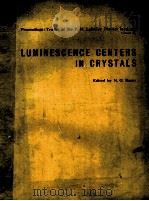
- LUMINESCENCE CENTERS IN CRYSTALS
- 1976 CONSULTANTS BUREAU NEW YORK AND LONDON
-
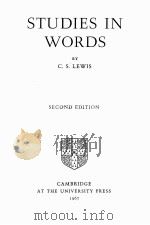
- STUDIES IN WORDS SECOND EDITION
- 1967 CAMBRIDGE AT THE UNIVERSITY PRESS
-
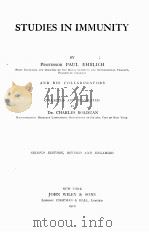
- STUDIES IN IMMUNITY SECOND EDITION
- 1910 JOHN WILEY AND SONS.
-
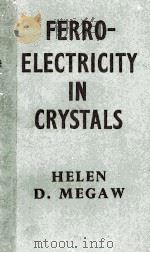
- FERROELECTRICITY IN CRYSTALS
- 1957 METHUEN AND CO LTD.
-

- DISORDER IN CRYSTALS
- 1978 CLARENDON PRESS
-
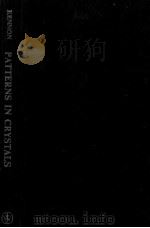
- PATTERNS IN CRYSTALS
- 1978 JOHN WILEY & SONS
提示:百度云已更名为百度网盘(百度盘),天翼云盘、微盘下载地址……暂未提供。➥ PDF文字可复制化或转WORD

